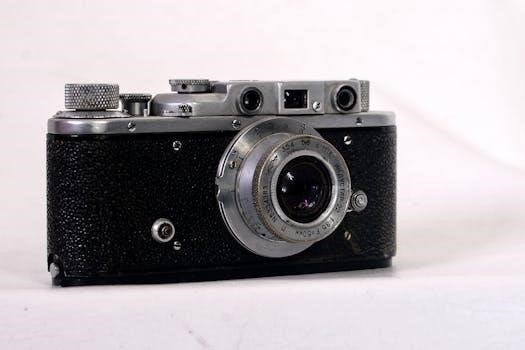Boss ME-90 Manual⁚ A Comprehensive Guide
Welcome to your comprehensive guide to the Boss ME-90! This resource is designed to assist you in navigating every function of this versatile guitar multi-effects processor. From initial setup to advanced tweaking‚ we’ll cover it all. Let’s unlock the full potential of your ME-90!
Overview of the Boss ME-90
The Boss ME-90 is a powerful and user-friendly guitar multi-effects processor designed for guitarists of all levels. It combines a wide array of high-quality effects‚ amp models‚ and practical features into a single‚ streamlined unit. This pedalboard offers both memory and manual modes‚ providing flexibility for different playing styles. In memory mode‚ you can store and recall 72 different patches‚ each containing a unique combination of effects and parameter settings. Manual mode‚ on the other hand‚ allows for real-time control over individual effects‚ giving you the feel of a traditional pedalboard. The ME-90 also features an expression pedal for dynamic control over parameters like wah‚ volume‚ and more.
Furthermore‚ the ME-90 integrates seamlessly with BOSS Tone Studio‚ a dedicated software application that enables you to edit effects‚ save settings‚ and download additional content from BOSS Tone Central. This includes access to a vast library of patches created by professional guitarists. The ME-90 can also function as an audio interface‚ allowing you to record directly into your computer via USB. It even supports loading impulse responses (IRs) for realistic cabinet simulation. Whether you’re a gigging musician‚ a recording artist‚ or a practice enthusiast‚ the ME-90 offers a comprehensive solution for shaping your guitar tone.
Accessing the Owners Manual
The Boss ME-90’s owner’s manual is your primary resource for understanding all its features and functions. You can access it in several convenient ways. The most direct method is to visit the official Boss website. Navigate to the support section and search for the ME-90 product page. Here‚ you’ll find downloadable PDF versions of the owner’s manual‚ startup guide‚ parameter guide‚ and other relevant documents.
Alternatively‚ you can often find the manual by simply searching online for “Boss ME-90 owner’s manual PDF.” Several websites host user manuals for various products‚ including the ME-90. Once you’ve located the PDF‚ you can view it on your computer‚ tablet‚ or smartphone. Consider downloading the manual for offline access‚ especially if you plan to use the ME-90 in locations without internet connectivity. The manual provides detailed instructions on everything from basic setup to advanced editing techniques. Take the time to familiarize yourself with its contents to unlock the full potential of your ME-90. Make sure to check the Boss website for any updates or revisions to the manual.
Understanding System Settings
The ME-90’s system settings govern global parameters that affect the overall operation of the unit. These settings are independent of individual patches and banks‚ so understanding them is crucial for optimizing your workflow. To access the system settings‚ refer to the owner’s manual for the specific button combination or menu navigation required.

Common system settings include adjusting the USB level for recording‚ configuring MIDI channels for external control‚ and managing USB loopback functionality. You can also fine-tune parameters like display brightness‚ pedal assignments‚ and output modes to suit your specific setup and preferences. Properly configuring these settings ensures seamless integration with your recording software‚ MIDI controllers‚ and amplification system. Experiment with different system settings to discover what works best for your playing style and equipment. Don’t be afraid to consult the manual for detailed explanations of each parameter and its potential impact on your sound. Remember to save your preferred system settings to ensure they are retained each time you power on the ME-90.

Switching Between Memory and Manual Modes
The Boss ME-90 offers two distinct operational modes⁚ Memory and Manual. Understanding the difference between these modes is key to unlocking the pedal’s flexibility. Memory Mode allows you to access and use pre-programmed patches. Think of these as snapshots of effect combinations and settings that you’ve saved for later use. You can navigate through banks and patches‚ selecting the perfect sound for each song section.
Manual Mode‚ on the other hand‚ transforms the ME-90 into a traditional stompbox array. In this mode‚ each footswitch directly controls an individual effect within the currently selected patch. This gives you on-the-fly control‚ allowing you to toggle effects on and off in real-time‚ just like you would with individual pedals. Switching between Memory and Manual Modes is typically done by pressing the MEMORY/MANUAL pedal. This allows for seamless transitions between pre-set sounds and real-time effect manipulation.
Exploring Patches and Banks
The Boss ME-90’s power lies in its ability to store and recall a vast array of sounds through its patch and bank system. A “patch” is essentially a complete setup of effects and their settings‚ acting as a single‚ cohesive sound. The ME-90 can store a significant number of these patches‚ allowing you to create a diverse sonic palette. These patches are organized into “banks.” Think of banks as folders‚ each containing a set of patches. This organization makes it easier to navigate and select the desired sound quickly during a performance.
Navigating through banks is typically achieved using dedicated “BANK” footswitches or buttons. Pressing these will move you up or down through the available banks. Once you’ve selected a bank‚ you can then choose a specific patch within that bank‚ again often using footswitches or buttons. Understanding this hierarchical structure – banks containing patches – is crucial for efficiently managing and utilizing the ME-90’s sound storage capabilities. Experiment with creating your own patches and organizing them logically within banks to optimize your workflow.
Using BOSS Tone Studio for ME-90
BOSS Tone Studio for the ME-90 is a dedicated software application that significantly expands the capabilities and ease of use of your multi-effects pedal. It acts as a central hub for editing‚ organizing‚ and sharing tones. Connecting your ME-90 to your computer via USB unlocks a world of possibilities‚ transforming the way you interact with your pedal.
Within BOSS Tone Studio‚ you can visually manipulate the ME-90’s parameters‚ making it easier to fine-tune your sound compared to using the pedal’s onboard controls alone. The software provides a clear‚ graphical representation of the signal chain‚ allowing you to adjust effect levels‚ EQ settings‚ and other parameters with precision. Furthermore‚ BOSS Tone Studio allows you to back up your ME-90’s settings‚ ensuring you never lose your carefully crafted tones. You can also use it to load new patches and system updates‚ keeping your ME-90 current with the latest features and sounds. It’s a must-have tool for any serious ME-90 user!

Downloading Patches from BOSS Tone Central
BOSS Tone Central is an online platform where you can find a vast library of patches created by professional guitarists and sound designers‚ all specifically tailored for BOSS products‚ including the ME-90. It’s an invaluable resource for expanding your sonic palette and discovering new tones. Accessing these patches is simple via the BOSS Tone Studio application.
First‚ ensure your ME-90 is connected to your computer and BOSS Tone Studio is running. Within the software‚ navigate to the Tone Central section. Here‚ you’ll find a variety of patches organized by genre‚ artist‚ and style. Browse through the selections and preview the patches to find sounds that appeal to you. Once you’ve found a patch you like‚ simply click the download button. The patch will then be transferred to your BOSS Tone Studio library. From there‚ you can easily load it onto your ME-90‚ ready for use in your playing. BOSS Tone Central is constantly updated with new content‚ so be sure to check back regularly for fresh inspiration.
Loading Impulse Responses (IRs)

The Boss ME-90 offers the capability to load impulse responses (IRs)‚ which are digital snapshots of speaker cabinets‚ allowing you to emulate the sound of various amplifiers and speaker setups directly in your pedalboard. This feature significantly expands the sonic possibilities of the ME-90‚ providing access to a wide range of tones beyond its built-in amp models.
To load IRs‚ you’ll need to use the BOSS Tone Studio application. Within the software‚ navigate to the IR loader section‚ typically found within the amp or cabinet simulation settings. From here‚ you can import your own IR files‚ which are commonly available online from various sources‚ both free and paid. The ME-90 supports specific IR file formats and lengths‚ so ensure your IRs are compatible. Once imported‚ you can assign the IR to a specific patch or amp model‚ allowing you to instantly switch between different cabinet emulations. Experimenting with different IRs can dramatically alter the character of your tone‚ making it an essential tool for crafting your signature sound. Remember to consult the manual for compatible file formats.
Connecting to a Computer via USB
Connecting your Boss ME-90 to a computer via USB unlocks a wealth of functionalities‚ enhancing its versatility and integration into your digital workflow. The USB connection serves multiple purposes‚ including MIDI data transmission‚ DAW control‚ and access to the Boss Tone Studio application; This connection allows for seamless editing‚ patch management‚ and firmware updates.
To establish the connection‚ use a standard USB cable to link the ME-90 to your computer. Once connected‚ your computer should recognize the device. You may need to install the dedicated USB driver for the ME-90‚ which can be downloaded from the Boss website. With the driver installed‚ the ME-90 can communicate with your DAW for recording and playback‚ as well as with the Boss Tone Studio. Within the Boss Tone Studio‚ you can edit effects‚ save settings‚ and manage patches. Connecting via USB also enables you to utilize the ME-90 as an audio interface‚ providing a convenient way to record your guitar directly into your computer. This integration transforms the ME-90 into a powerful tool for both live performance and studio recording.